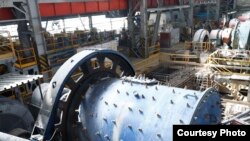First-half data released by the government’s Statistical Committee shows a more than 7 percent decrease in the production of metal ores and ore concentrates which totaled 218 billion drams ($566 million). The production of copper, molybdenum and other base metals was down by as much as 16 percent year on year, at 74.4 billion drams.
This was one of the reasons why overall Armenian industrial output, worth about 1.2 trillion drams ($3 billion), was practically stagnant, contrasting with a roughly 10 percent increase in GDP recorded by the Statistical Committee in January-June 2023.
Economic growth continued to be primarily driven by double-digit gains in trade and other services resulting from massive cash inflows from Russia sparked by Western sanctions against Moscow. Armenia’s trade with Russia has skyrocketed since the Russian invasion of Ukraine.
The Armenian mining industry remains oriented towards Western markets. The South Caucasus country’s largest metallurgical enterprise, the Zangezur Copper-Molybdenum Combine (ZCMC), is also its number one corporate taxpayer.
Based in Kajaran, a town in Armenia’s Syunik province, ZCMC employs about 4,000 people. The State Revenue Committee (SRC) collected a total of 35 billion drams in various taxes from ZCMC in the first half 2023, compared with 105 billion drams last year.
A smaller company mining copper and molybdenum near another Syunik town, Agarak, was seventh in the SRC’s 2022 tax rankings. Now it is not even among the country’s 100 leading taxpayers.
Some analysts blame these sharp decreases on a recent fall in global metal prices. A significant strengthening of the Armenian dram, another side effect of the Western sanctions, may be another factor.
The British-registered parent company of another Syunik-based mining enterprise, Chaarat Kapan, singled out the exchange rate fluctuation in an August 16 statement announcing its decision to sell Chaarat Kapan to another firm for over $55 million.
Chaarat Kapan has about 1,000 workers. Hundreds of them went on strike last year to demand better pay and working conditions. The company management said at the time that it cannot afford pay rises because of the stronger dram and other unfavorable global developments.
Also, Armenia’s largest gold mine located on the border with Azerbaijan was largely shut down this spring due to systematic cross-border gunfire targeting its workers and production facilities. A Russian company operating the Sotk mine stopped open-pit mining there and put many of its 700 workers on unpaid leave.
“Unless new mines are opened, the mining industry will start slowly declining,” said Hrant Mikaelian, an analyst with the Yerevan-based Caucasus Institute. “As far as I know, the creation of new mines has been very slow in recent years.”







